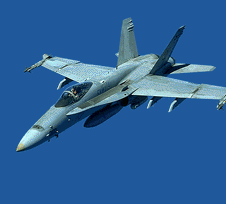McDonnell Douglas F/A-18 Hornet

McDonnell Douglas F/A-18 Hornet
Role: Carrier-borne and land-based attack/fighter.
DESIGN FEATURES:
Sharp-edged, cambered leading-edge extensions (LEX),
slots at fuselage junction and outward-canted twin fins
are designed to produce high agility and docile
performance at angles of attack over 50 degrees; wings
have 20 degrees sweepback at quarter-chord; wings fold
up 90 degrees at inboard end of ailerons, even on
land-based F/A-18s; landing gear designed for unflared
landings on runways as well as on carriers.
STRUCTURE:
Multi-spar wing mainly of light alloy, with
graphite/epoxy inter-spar skin panels and trailing-edge
flaps; tail surfaces mainly graphite/epoxy skins over
aluminium honeycomb core; graphite/epoxy fuselage
panels and doors; titanium engine firewall. Northrop
Grumman produces rear and centre fuselages; assembly
and test at McDonnell Douglas St Louis factory; CASA
produces horizontal tail surfaces, flaps, leading-edge
extensions, speedbrakes, rudders and rear side panels
for all F/A-18s.
LANDING GEAR:
Dowty retractable tricycle type, with twin-wheel nose
and single-wheel main units. Nose unit retracts
forward, surface of the engine air ducts. Bendix wheels
and brakes. Nosewheel tyres size 22 x 6.6-10, 20 ply,
pressure 24.13 bars (350 lb/sq in) for carrier
operations, 10.34 bars (150 lb/sq in) for land
operations. Mainwheel tyres size 30 x 11.5-14.5, 24
ply, pressure 24.13 bars (350 lb/sq in) for carrier
operations, 13.79 bars (200 lb/sq in) for land
operations.
POWER PLANT:
Two General Electric F404-GE-400 low bypass turbofans
initially, each producing approx 71.2 kN (16,000 lb st)
with afterburning. F404-GE-402 EPE (Enhanced
Performance Engine) standard from early 1992; rated at
approx 78.3 kN (17600 lb st). Self-sealing fuel tanks
and fuel lines; foam in wing tanks and fuselage voids.
Internal fuel capacity (JP5) approx 6061 litres (1600
US gallons; 1333 Imp gallons). Provision for up to
three 1250 litre (330 US gallon; 275 Imp gallon)
external tanks.
ACCOMMODATION:
Pilot only, on Martin-Baker SJU-5/6 ejection seat, in
pressurised, heated and air-conditioned cockpit. Upward
opening canopy, with separate windscreen, on all
versions. Two pilots in F/A-18B and USN F/A-18D; pilot
and Naval Flight Officer in USMC F/A-18D.
AVIONICS:
Include an automatic carrier landing system (ACLS) for
all-weather carrier operations; a Hughes Aircraft
AN/APG-65 multi-mode digital air-to-air and
air-to-ground tracking radar, with air-to-air modes
which include velocity search (VS), range while search
(RWS), track while scan (TWS), which can track 10
targets and display eight to the pilot, and raid
assessment mode (RAM). Hughes AN/APG-73 radar in C/Ds
for USN, USMC, Finland, Malaysia and Switzerland from
May 1994. Smiths Industries multi-purpose colour map
display; two Kaiser monochrome MFDs (colour on Night
Attack Hornets). Collins AN/ARN-118 Tacan, AN/ARC-182
UHF/VHF com and DF-301E UHF/DF; Magnavox AN/ALR-50 and
Litton AN/ALR-67 RWRs; GEC-Marconi Type 117 laser
designator; Harris AN/ASW-25 radio data link; Eaton
AN/ARA-63 receiver/decoder; GEC-Marconi FID 2035
horizontal situation display; Bendix/King HSI; J. E. T.
ID-1791/A flight director indicator; General Electric
quadruple-redundant fly-by-wire flight control system,
with direct electrical backup to all surfaces and
direct mechanical backup to tailerons; two Control Data
AN/AYK-14 digital computers; Litton AN/ASN-130A
inertial navigation system (plus GPS from FY 1993), but
being replaced by Litton AN/ASN-139 ring laser system
(including retrofits); two Kaiser multi-function CRTs,
central GEC-Marconi-Bendix/King CRT and Kaiser
AN/AVQ-28 HUD; Conrac communications system control;
Normalair-Garrett digital data recorder for Bendix/King
maintenance recording system; flight incident recording
and monitoring system (FIRAMS).
ARMAMENT:
Nine external weapon stations, comprising two wingtip
stations for AIM-9 Sidewinder air-to-air missiles; two
outboard wing stations for an assortment of air-to-air
or air-to-ground weapons, including AIM-7 Sparrows,
AIM-9 Sidewinders, AIM-120 AMRAAMs (launch trials by
VX-4 in 1992; cleared for squadron use mid-1993),
AGM-84 Harpoons and AGM-65F Maverick missiles; two
inboard wing stations for external fuel tanks,
air-to-ground weapons or Brunswick ADM-141 TALD
tactical air-launched decoys; two nacelle fuselage
stations for Sparrows or Martin-Marietta AN/ASQ-173
laser spot tracker/strike camera (LST/SCAM) or
AN/AAS-38 and AN/AAR-50 sensor pods (see Avionics); and
a centreline fuselage station for external fuel or
weapons. Air-to-ground weapons include GBU-10 and -12
laser-guided bombs, Mk 82 and Mk 84 general purpose
bombs, and CBU-59 cluster bombs. An M61A1 20 mm
six-barrel gun, with 570 rounds, is mounted in the nose
and has a McDonnell Douglas director gunsight, with a
conventional sight as backup.
Aircraft Measures:
Length: 56 ft.
Height: 15 ft., 3.5 in.
Wingspan: 37 ft., 6 in.
Loaded Weight: 36,710 lbs
Aircraft Performance:
Maximum Speed: Mach 1.8+
Service Ceiling: 50,000 ft.
Range: 2,303 miles
Thrust: 32,000
